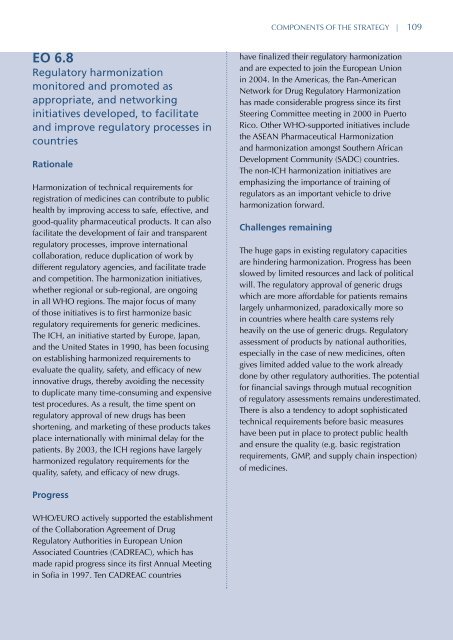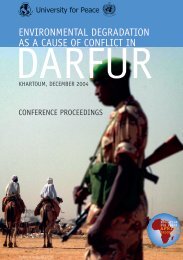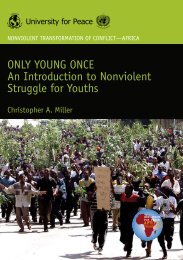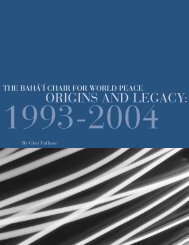who medicines strategy - libdoc.who.int - World Health Organization
who medicines strategy - libdoc.who.int - World Health Organization
who medicines strategy - libdoc.who.int - World Health Organization
Create successful ePaper yourself
Turn your PDF publications into a flip-book with our unique Google optimized e-Paper software.
COMPONENTS OF THE STRATEGY | 109EO 6.8Regulatory harmonizationmonitored and promoted asappropriate, and networkinginitiatives developed, to facilitateand improve regulatory processes incountriesRationaleHarmonization of technical requirements forregistration of <strong>medicines</strong> can contribute to publichealth by improving access to safe, effective, andgood-quality pharmaceutical products. It can alsofacilitate the development of fair and transparentregulatory processes, improve <strong>int</strong>ernationalcollaboration, reduce duplication of work bydifferent regulatory agencies, and facilitate tradeand competition. The harmonization initiatives,whether regional or sub-regional, are ongoingin all WHO regions. The major focus of manyof those initiatives is to first harmonize basicregulatory requirements for generic <strong>medicines</strong>.The ICH, an initiative started by Europe, Japan,and the United States in 1990, has been focusingon establishing harmonized requirements toevaluate the quality, safety, and efficacy of newinnovative drugs, thereby avoiding the necessityto duplicate many time-consuming and expensivetest procedures. As a result, the time spent onregulatory approval of new drugs has beenshortening, and marketing of these products takesplace <strong>int</strong>ernationally with minimal delay for thepatients. By 2003, the ICH regions have largelyharmonized regulatory requirements for thequality, safety, and efficacy of new drugs.have finalized their regulatory harmonizationand are expected to join the European Unionin 2004. In the Americas, the Pan-AmericanNetwork for Drug Regulatory Harmonizationhas made considerable progress since its firstSteering Committee meeting in 2000 in PuertoRico. Other WHO-supported initiatives includethe ASEAN Pharmaceutical Harmonizationand harmonization amongst Southern AfricanDevelopment Community (SADC) countries.The non-ICH harmonization initiatives areemphasizing the importance of training ofregulators as an important vehicle to driveharmonization forward.Challenges remainingThe huge gaps in existing regulatory capacitiesare hindering harmonization. Progress has beenslowed by limited resources and lack of politicalwill. The regulatory approval of generic drugswhich are more affordable for patients remainslargely unharmonized, paradoxically more soin countries where health care systems relyheavily on the use of generic drugs. Regulatoryassessment of products by national authorities,especially in the case of new <strong>medicines</strong>, oftengives limited added value to the work alreadydone by other regulatory authorities. The potentialfor financial savings through mutual recognitionof regulatory assessments remains underestimated.There is also a tendency to adopt sophisticatedtechnical requirements before basic measureshave been put in place to protect public healthand ensure the quality (e.g. basic registrationrequirements, GMP, and supply chain inspection)of <strong>medicines</strong>.ProgressWHO/EURO actively supported the establishmentof the Collaboration Agreement of DrugRegulatory Authorities in European UnionAssociated Countries (CADREAC), which hasmade rapid progress since its first Annual Meetingin Sofia in 1997. Ten CADREAC countries











